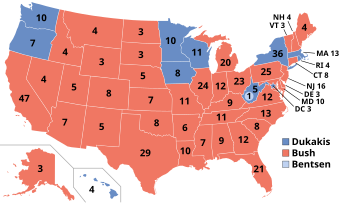
Back الانتخابات الرئاسية الأمريكية 1988 Arabic انتخابات رياسة امريكا 1988 ARZ ھەڵبژاردنی سەرۆکایەتیی ویلایەتە یەکگرتووەکانی ئەمریکا (١٩٨٨) CKB Præsidentvalget i USA 1988 Danish Präsidentschaftswahl in den Vereinigten Staaten 1988 German Προεδρική εκλογή των Ηνωμένων Πολιτειών 1988 Greek Elecciones presidenciales de Estados Unidos de 1988 Spanish انتخابات ریاستجمهوری ایالات متحده آمریکا (۱۹۸۸) Persian Yhdysvaltain presidentinvaalit 1988 Finnish Élection présidentielle américaine de 1988 French
| |||||||||||||||||||||||||||||
538 members of the Electoral College 270 electoral votes needed to win | |||||||||||||||||||||||||||||
|---|---|---|---|---|---|---|---|---|---|---|---|---|---|---|---|---|---|---|---|---|---|---|---|---|---|---|---|---|---|
| Turnout | 52.8%[1] | ||||||||||||||||||||||||||||
| |||||||||||||||||||||||||||||
 Presidential election results map. Red denotes states won by Bush/Quayle and blue denotes those won by Dukakis/Bentsen. Light blue is the electoral vote for Bentsen/Dukakis by a West Virginia faithless elector. Numbers indicate electoral votes cast by each state and the District of Columbia. | |||||||||||||||||||||||||||||
| |||||||||||||||||||||||||||||
Presidential elections were held in the United States on November 8, 1988. The Republican Party's ticket of incumbent Vice President George H. W. Bush and Indiana Senator Dan Quayle defeated the Democratic ticket of Massachusetts Governor Michael Dukakis and Texas Senator Lloyd Bentsen. The election was the third consecutive and most recent landslide victory for the Republican Party. As of 2024, it remains the most recent election in which a candidate won over 400 electoral votes, as well as 40 or more states.[2] Conversely, it began an ongoing streak of presidential elections that were decided by a single-digit popular vote margin.[3]
President Ronald Reagan was ineligible to seek a third term because of the 22nd Amendment. It was the first election since 1968 to lack an incumbent president on the ballot. Reagan was also the first incumbent president since Dwight D. Eisenhower in 1960 to be barred from seeking reelection. Bush entered the Republican primaries as the front-runner, defeating Kansas Senator Bob Dole and televangelist Pat Robertson. He selected Indiana Senator Dan Quayle as his running mate. Dukakis, an early Atari Democrat, won the Democratic primaries after Gary Hart (another prominent Atari Democrat, forerunning the New Democrats of the 1990s) and Ted Kennedy (representing the traditional liberal wing of the Democratic Party) withdrew or declined to run. He selected Texas Senator Lloyd Bentsen as his running mate.
Bush ran an aggressive campaign that concentrated mainly on the strong economy, reduction in crime, and continuance with Reagan's policies. He attacked Dukakis as an elitist "Massachusetts liberal", to which Dukakis ineffectively responded. Despite Dukakis initially leading in the polls, Bush pulled ahead after the Republican National Convention and extended his lead after two strong debate performances. Bush won a decisive victory over Dukakis, winning the Electoral College and the popular vote by sizable margins. Bush became the first sitting vice president to be elected president since Martin Van Buren in 1836, and the first vice president to be elected president since Richard Nixon (as former vice president) in 1968. This was the last presidential election in which an incumbent vice president was elected president, although Joe Biden was elected in 2020 as a former vice president.
The 1988 presidential election was the first since 1948 that a party won a third consecutive term, and the first time for the Republicans since 1928. As of 2024, this has not happened since; from 1992 onward, neither party has been able to win the presidency more than two consecutive times. Additionally, 1988 was the most recent time that the Republicans won the popular vote in consecutive elections, and the latest in which a Republican who had not already served as president won the popular vote. This is the most recent presidential election in which the Democratic nominee did not win at least 200 electoral votes. It is also the most recent presidential election in which the Republican nominee won the female vote, as well as the last presidential election in which the Rust Belt states of Michigan, Pennsylvania, and Wisconsin did not vote for the same candidate.[4]
As of 2024, this remains the last time that a Republican has carried California, Connecticut, Delaware, Illinois, Maine,[b] Maryland, New Jersey, and Vermont. New Mexico would not vote Republican again until 2004, while Michigan and Pennsylvania would not do so again until 2016. Since the death of Jimmy Carter in 2024, this is the earliest election in which at least one of the major party nominees for president (Dukakis) or vice president (Quayle) is still alive (Bentsen died in 2006 and Bush died in 2018).
- ^ "National General Election VEP Turnout Rates, 1789-Present". United States Election Project. CQ Press. Archived from the original on November 14, 2016. Retrieved February 21, 2023.
- ^ "Electoral College's Stately Landslide Sends Bush and Quayle Into History". The New York Times. December 20, 1988. Archived from the original on August 1, 2023. Retrieved January 18, 2025.
- ^ Enten, Harry (December 26, 2022). "The most underdiscussed fact of the 2022 election: how historically close it was". CNN. Retrieved December 26, 2022.
- ^ Brownstein, Ronald (September 16, 2024). "Why these three states are the most consistent tipping point in American politics". CNN. Retrieved September 16, 2024.
Cite error: There are <ref group=lower-alpha> tags or {{efn}} templates on this page, but the references will not show without a {{reflist|group=lower-alpha}} template or {{notelist}} template (see the help page).

